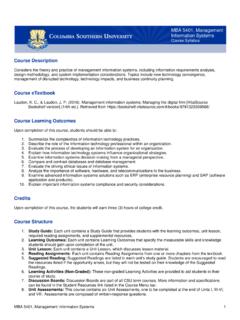Transcription of What's New in Obesity Treatment - …
1 March 22, 2018 Presenter:James O. Hill, Depts of Pediatrics & MedicineUniversity of Colorado School of MedicineModerator:James M. Rippe, MD Leading cardiologist, Founder and Director; Rippe Lifestyle Institute Approved for 1 CPE (Level 2) by the Commission on Dietetic Registration, credentialing agency for the Academy of Nutrition and Webinar SeriesWhat's New in Obesity TreatmentConagra Nutrition MissionWe believe that everyone deserves easy access to understandable, credible, and science-based nutrition information. Webinar logistics CEUs a linkto obtain your Continuing Education Credit certificate will be available on this webinar s page at emailed to you within 2 days.
2 A recording of today s webinar and slides as a PDF will be available to download within 2 daysa t : The presenter will answer questions at the end of this webinar. Please submit questions by using the Chat dialogue box on your computer s Faculty James O. Hill, PhDProfessor Depts of Pediatrics & MedicineUniversity of Colorado School of Medicine Moderator:James M. Rippe, MD Leading and Director, Rippe Lifestyle Institute Learning Objectives To understand that current success in long-term Treatment of Obesity is poor To identify reasons for poor success in long-term Treatment of Obesity To review new approaches and new concepts that can be incorporated into Treatment programs to increase success To provide practical strategies that can be incorporated into Obesity Treatment programsNUTRI-BITES Webinar SeriesWhat's New in Obesity TreatmentWhat s New in Weight Management?
3 James O. Hill, & MedicineUniversity of Colorado School of MedicineWe have been seriously addressing Obesity for 3 decadesHow are we doing?Overweight BMI >30 kg/m2 Obesity BMI >25 and <30 kg/m2 Extreme Obesity BMI >40 kg/m2 Note: Overweight is defined as BMI>=gender and weight-specific 95th percentile from the 2000 CDC Growth Charts. Source: National Health Examination Surveys II (ages 6-11) and III (ages 12-17), National Examination Surveys, I, II, III and 1999-204, NCHS, 12-19 Age 6-11 Age 2-5 Trends in child and adolescent overweightFigure 5.
4 Trends in Obesity prevalence among adults aged 20 and over (age adjusted) and youth aged 2 19 years: United States, 1999 2000 through 2015 2016 Comparison of weight loss diets with different compositions of fat, protein and carbohydrates (n=811)Sacks FS. et al. NEJM2009;360(9) 859-873 WEIGHT LOSSWEIGHT Re-GAINWhat we are doing is not working If I had an hour to solve a problem, I would spend 55 minutes on understanding the problem and 5 minutes on the solution. We need to think about the problem in a new wayHow to treat Obesity Produce weight loss Help people keep weight off foreverHeight 5 7 Weight 400 lbsBMI 60 PrediabeticElevated BPElevated lipidsConstant joint painNo friendsNo social lifeLow self-esteemDepressedVery UnhappyWhat do you recommend for Jen?
5 Surgery - 25-40% long-term success; regain in some; major life change Medications -~7-10% most regained Devices -~7-10% unclear Lifestyle 7-10% most regainedTreatment OptionsBarriers to Success Focus on weight loss rather than weight loss maintenance Diet confusion Failure to appreciate human biology Our goals are too low Failure to understand the WHY Failure to provide long-term supportThe Energy Balance SystemEnergy IntakeEnergy ExpenditureEnergyStoresMetabolic RegulationEnvironmental FactorsBehavioral Factors Food environment Physical activity environment Built environment Social environment
6 Amount and composition of food intake Amount and type of physical activity SleepHuman BiologyBut, my metabolism is brokenStart with human biologyMetabolic flexibility in physiological situationsMetabolic flexibility at the level of skeletal muscle and adipose tissueGoodpaster B and Sparks LM Cell metabolism, 2017 Phenotypic flexibilityAll peripheral organs have the ability to respond to metabolic challenge, and can contribute to the regulation of metabolic flexibilityVan Ommen B. Gens Nutr, 2014 Physical activity predicts metabolic flexibility Bergouignan A et al.
7 J Appl Physiol 2011;111:1201-1210 What is best way to get weight off? Any diet works as long as it creates negative energy balance Exercise helps but you have to do a lot Weight loss is time limitedGardner et al. JAMA 2018 Average weight loss = kg (5%)Average weight loss at 1 year = 6 kg (6%)Average weight loss = kg (5%)Foster et al. Ann Intern Med. 2010;153: weight loss at 1 year = kg ( )Average weight loss at 2 year = kg ( )Average weight loss at 1 year = kg ( )Average weight loss at 2 year = kg ( )Metabolic Changes with Weight Loss Energy expenditure declines Compensatory changes in hormones/processes that facilitate fat storage Hunger increasesThe Energy GapBody WeightTimeenergy gapPre-Weight Loss Metabolic RatePost-Weight Loss Metabolic Rate Food restriction Exercise MedicationsEnvironmental Factors Possibly Contributing to ObesityFood is good tasting, convenient, inexpensiveIt is easy to eliminate most physical activity from daily lifeComparison of weight loss diets with different compositions of fat, protein and carbohydrates (n=811)
8 Sacks FS. et al. NEJM2009;360(9) 859-873 WEIGHT LOSSWEIGHT Re-GAINB iologyEnvironmentBehaviorWhy is Weight Loss Maintenance Hard?OptimizeMetabolismBody WeightEnergy IntakePhysical Activity Threshold for Optimal Weight Regulation Unregulated Zone Regulated ZoneAdapted from Mayer et. al., 1956 Increase in physical activity Modifying the Environment What factors would make a difference if modified? What factors are modifiable? Most changes oppose biology- Eat less of foods that taste really good- Hard-wired to like sugar, fat, salt- move when you don t have to change will be likely that we can modify the environment sufficiently that no cognitive effort is neededSwimming UpstreamBiologyEnvironmentBehaviorWhy is Maintaining a Healthy Weight Hard?
9 MotivationOnly of adults met criteria of 1) healthy diet; 2) adequate physical activity; 3) healthy weight; 4) non-smoking-Loprinzi et al. Mayo Clinic Proc 2016 State of Slim: TRANSFORMATIVEWEIGHT Transformational Weight ManagementTranslating the Science: Development of State of Slim (SOS) National Weight Control Registry Hill/Wyatt Research ProgramDPPLook Ahead State of Slim Extreme Weight Loss reality show Destination Boot CampSOS Based on >30 years of research >10,000 participants Avgweight loss >70 lbs Avglength of maintenance > 6 years >25 publications Identify common behaviors among those most successful in weight loss maintenanceThe National Weight Control RegistryWhat they do.
10 Commonalities among NWCR participants in weight maintenance Low fat diet, attention to calories Self-monitoring Behavioral consistency Dietary restraint Breakfast High levels of physical activityABC S EXTREME WEIGHT LOSST ransformationBIGGER THAN WEIGHT LOSS47%BehaviorMindsetMotivationTransfor mationWhatWhyHowLifestyle Changes (WHAT) metabolism-Exercise about 1 hour/day-Sleep may contribute; need more the weight energy gap-Weight loss driven by caloric restriction-Maintenance energy density; portion size; diet to match metabolism-Exercise tweak from 60 min/dayPhases of State of Slim Phase 1 get weight off dramatic change (2 weeks) Phase 2-begin fixing metabolism (6 weeks) Phase 3 maintain activity while learning to eat smart (8 weeks) Each phase addresses what, why, and howMotivation: Alignment of Purpose (WHY) Aligning your lifestyle with your purpose Looking for connections between your life goals and your lifestyleWhat is Your Deeper Why?








